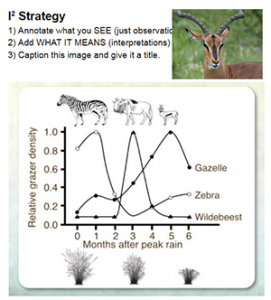
In order to convert my lectures to phenomenon-based lessons, I started the community interaction chapter with a mini-case about how animals on the savanna share one resource, grasses. The idea is that students would slowly build their understanding of how energy transfers through ecosystems and how populations within an area are limited by those resources.
The lesson builds on an HHMI’s Niche Partitioning Activity , though I made the information much simpler for freshman students. Using class discussion, pair/share observations and a combination of slides and graphs, students should be able to construct an explanation to the question: “How do savanna animals share one resource, a grassland plant?”
The graph is provided by HHMI and I make copies for students that have the caption removed. They must use the I2 (Identify and Interpret) strategy to evaluate and then create their own caption for the graph.
The slides include anatomical information about ruminants as another piece of the puzzle regarding resource partitioning. The unique anatomy of zebras allows them to digest low quality food more quickly than the other ruminants, the wildebeests and gazelles.
Modeling Animal Habitats
Students eventually develop a model of how similar animals can occupy the same habitat. They given the concept “competitive exclusion principle” and then asked to apply it to two other situations, warblers that occupy different areas of trees and predatory birds that live near lakes.
In all cases, students must develop their own hypotheses about how these species can coexist together. A final “exit ticket” assignment is given for students to synthesize the information.
HHMI Biointeractive has several other activities related to Gorongosa National Park
Google Slides – to edit, create a copy for your own drive.
Time Required: 30-45 minutes
Grade Level: 9-12
HS-LS2-2 Use mathematical representations to support and revise explanations based on evidence about factors affecting biodiversity and populations in ecosystems of different scales.
SEP – 1) Asking questions (for science) and defining problems 2) Developing and using models 4) Analyzing and interpreting data
CCC 1. Patterns. Observed patterns of forms and events guide organization and classification, and they prompt questions about relationships and the factors that influence them.

